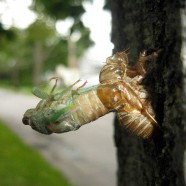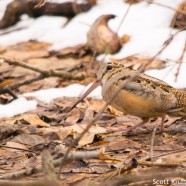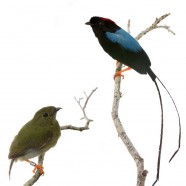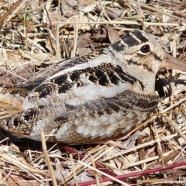Cicada Season
Cicada season has arrived! The first chorus of the season is sounding from treetops across the local landscape. These fascinating insects spend many years subsisting in the subterranean realm feeding on tree sap before finally emerging for their brief nuptial song and dance. Listen for their rattling cacophony and look for their crunchy molts on tree trunks over the next several weeks.
Read MoreAmerican Woodcock in March Snow
I was delighted to find this American Woodcock (Scolopax minor) feeding in the exposed leaf litter and mud thanks to the warm, flowing spring and expansive wetlands in my yard today after about six more inches of snow fell yesterday and early this morning. Note the muddy end of this shorebird’s bill showing it had been busy foraging throughout the day in this video… …and the photos below: This well-known spring species dances on the ground while foraging and in the sky while courting every March, though this year the displays may be a little later than usual. The sun is so...
Read MoreLong-tailed Manakin (Chiroxiphia linearis) Pair
We have showed you the exquisite male previously but here we have both the Long-tailed Manakin (Chiroxiphia linearis) male and a lovely female by RTPI Affiliate Sean Graesser. He notes that you can see the interesting sexual dimorphism Manakins have. Most species congregate in a lek, where the males perform a dance for the female, after which she makes the nest and raises the chicks. Photographed for the Meet Your Neighbours global biodiversity project in Costa Rica.
Read MoreThe unique American Woodcock
American Woodcocks (Scolopax minor) are so very unique. They are shorebirds that live in the forest, foraging in the leaf litter, or old fields. They take flight in astoundingly graceful courtship displays each year around this date on the calendar when the evenings begin to warm up. As you can see in both this photo and the subsequent videos they have tremendously evolved features such as that enormous eye that seems like it can spot you at 360 degrees at all times and a body pattern that makes them almost invisible to our eyes, even up close. You may have already seen this video we posted...
Read More







